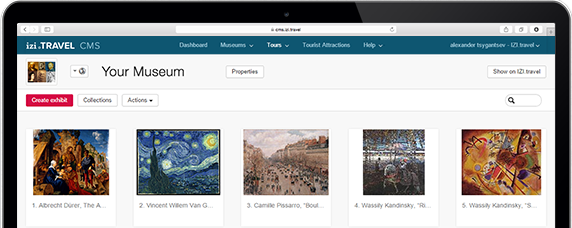Museum The Egyptian Museum in Cairo
- Download the applinks
- iOS
- Android
- Windows Phone
Museum-info
Over het museum
Egyptian Museum in Cairo is one of the top attraction you must visit while you are in Cairo City
The History of The Museum
The Museum contains many important pieces of ancient Egyptian history. It houses the world's largest collection of Pharaonic antiquities. The Egyptian government established the museum built in 1835 near the Ezbekieh Garden and later moved to the Cairo Citadel. In 1855, Archduke Maximilian of Austria was given all of the artifacts by the Egyptian government; these are now in the Kunsthistorisches Museum, Vienna.
A new museum was established at Boulaq in 1858 in a former warehouse, following the foundation of the new Antiquities Department under the direction of Auguste Mariette.
The building lay on the bank of the Nile River, and in 1878 it suffered significant damage owing to the flooding of the Nile River. In 1891, the collections were moved to a former royal palace, in the Giza district of Cairo.
They remained there until 1902 when they were moved again to the current museum in Tahrir Square, built by the Italian company of Giuseppe Garozzo and Francesco Zaffrani to a design by the French architect Marcel Dourgnon.
In 2004, the museum appointed Wafaa El Saddik as the first female director general.
During the Egyptian Revolution of 2011, the museum was broken into, and two mummies were destroyed.
Several artifacts were also shown to have been damaged and around 50 objects were lost.
Since then, 25 objects have been found.
Those that were restored were put on display in September 2013 in an exhibition entitled Damaged and Restored.
Among the displayed artifacts are two statues of King Tutankhamun made of cedar wood and covered with gold, a statue of King Akhenaten, ushabti statues that belonged to the Nubian kings, a mummy of a child, and a small polychrome glass vase.
Interior design of Egyptian Museum
There are two main floors in the museum, the ground floor and the first floor. On the ground floor there is an extensive collection of large-scale works in stone including statues, reliefs and architectural elements. These are arranged chronologically in clockwise fashion, from the pre-dynastic to the Greco-Roman period.
The first floor is dedicated to smaller works, including papyri, coins, textiles, and an enormous collection of wooden sarcophagi. The numerous pieces of papyrus are generally small fragments, owing to their decay over the past two millennia. Several languages are found on these pieces, including Greek, Latin, Arabic, and ancient Egyptian. The coins found on this floor are made of many different metals, including gold, silver, and bronze. The coins are not only Egyptian, but also Greek, Roman, and Islamic. This has helped historians research the history of Ancient Egyptian trade.
Also on the ground floor are artifacts from the New Kingdom, the time period between 1550 and 1069 BC. These artifacts are generally larger than items created in earlier centuries. Those items include statues, tables, and coffins (sarcophagi). It contains 42 rooms; upon entering through the security check in the building, one looks toward the atrium and the rear of the building with many items on view from sarcophagi and boats to enormous statues.
On the first floor there are artifacts from the final two dynasties of Egypt, including items from the tombs of the Pharaohs; Thutmosis III, Thutmosis IV, Amenophis II, Hatshepsut, and the courtier Maiherpri, as well as many artifacts from the Valley of the Kings, in particular the material from the intact tombs of Tutankhamun and Psusennes I. Two special rooms contain a number of mummies of kings and other royal family members of the New Kingdom. On April 3, 2021, twenty-two of these mummies were transferred to the National Museum of Egyptian Civilization in Fustat in a grand parade dubbed The Pharaohs' Golden Parade.
Memorial to famous Egyptologists
the Most Important collection you must see at the Museum
1- The Gold Mask of Tutankhamun, composed of 11 kg of solid gold
2- The Grave Mask of king Amenemope of the 21st dynasty
3-Mummy mask of Psusennes I
4-Ramesses III prisoner tiles
5-Colossal statue of Amenhotep III and Tiye
6-Figurine of Khufu
7-Khafre Enthroned
8-Statue of Menkaure
9-Bust of Akhenaten
10-Statue of Hatshepsut
11-Narmer Palette
12-Merneptah Stele
13-Mummy mask of Wendjebauendjed
14-Rahotep and Nofret (2575-2550 BC)
15-Dwarf Seneb with his wife (2400-2500 BC)
16-Canopic box from Tutankhamun's tomb
17-Throne of Tutankhamun
18-Wood sculptural composition depicting a cattle census scene (2000 BC)
19-Pyramidion from the pyramid of Amenemhat III at Dashur
Plan je bezoek


- شارع التحرير, الإسماعيلية, باب اللوق, Caïro, Caïro (gouvernement), 11519, Egypte
- www.emotoursegypt.com/en
Beoordelingen
Download de gratis izi.TRAVEL app
Maak eigen audiogidsen!
Het gebruik van het systeem en de app is gratis



